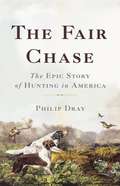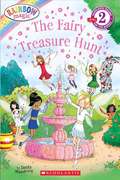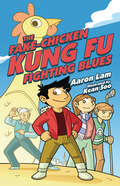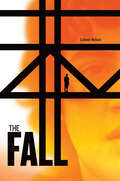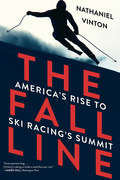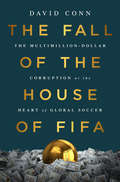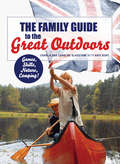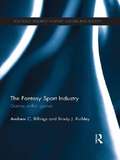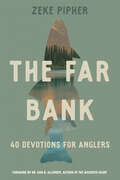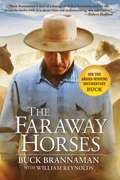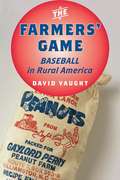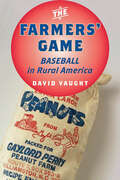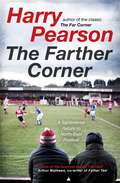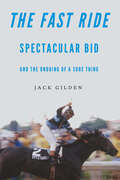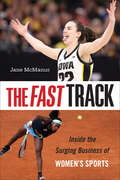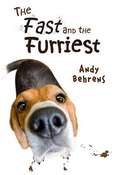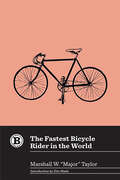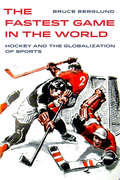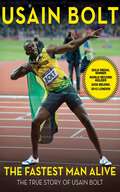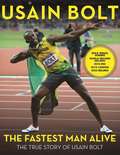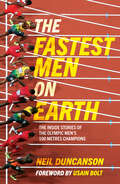- Table View
- List View
The Fair Chase: The Epic Story of Hunting in America
by Philip DrayAn award-winning historian tells the story of hunting in America, showing how this sport has shaped our national identity.From Daniel Boone to Teddy Roosevelt, hunting is one of America's most sacred-but also most fraught-traditions. It was promoted in the 19th century as a way to reconnect "soft" urban Americans with nature and to the legacy of the country's pathfinding heroes. Fair chase, a hunting code of ethics emphasizing fairness, rugged independence, and restraint towards wildlife, emerged as a worldview and gave birth to the conservation movement. But the sport's popularity also caused class, ethnic, and racial divisions, and stirred debate about the treatment of Native Americans and the role of hunting in preparing young men for war. This sweeping and balanced book offers a definitive account of hunting in America. It is essential reading for anyone interested in the evolution of our nation's foundational myths.
The Fairy Treasure Hunt
by Daisy MeadowsThe Jewel Fairies are going on a treasure hunt! Time for a treasure hunt! The Jewel Fairies are searching Fairyland for the magical jewels that give all fairies their special powers. If they can find them all, they will be granted a very special gift-- beautiful jeweled pendants! After a very busy day, only one is left. The fairies must combine their magic to help Sophie the Sapphire earn her necklace.
The Fake-Chicken Kung Fu Fighting Blues (Lorimer Illustrated Humor)
by Aaron LamTwelve-year-old video buff Anthony is devastated when his family moves from Chinatown to a remote northern community. There are no other Asian families around and everyone loves hockey, which Anthony just doesn't get. The move is even harder on his grandmother, Po Po, who doesn't speak English and puts a fake chicken over the front door for luck. Desperate to fit in, Anthony takes to the ice for the first time — and is a total disaster! But he manages to make friends after standing up the school bully, who asks Anthony to teach him "kung fu"! Anthony starts putting together a documentary about his new town, which turns out to be full of interesting people. As he discovers the joys of small-town life, his new friends get an introduction to his Chinese culture, and even Po Po begins to feel at home. Distributed in the U.S by Lerner Publishing Group
The Fall
by Colleen NelsonWINNER, McNally Robinson Book for Young People Award, 2014FINALIST, Forest of Reading, White Pine Award 2013SELECTION, Best Books for Kids and Teens, Fall 2013When one teen dies in a tragic accident, the lives of three others are forever changed. One turns to alcohol to escape his guilt. Another looks to a gang to replace what he' s lost. Ben must find the strength to break through a growing web of lies and convince everyone at school that he was not to blame. But first he has to convince himself.
The Fall Line: America's Rise to Ski Racing's Summit
by Nathaniel VintonA journey into the world's original extreme sport: downhill ski racing. Harnessing nature's most powerful forces, elite downhillers descend icy, rugged slopes at speeds cresting 90 miles per hour. For decades, American skiers struggled to match their European counterparts, and until this century the US Ski Team could not claim a lasting foothold on the roof of the Alps, where the sport's legends are born. Then came a fledgling class of American racers that disrupted the Alpine racing world order. Led by Bode Miller and Lindsey Vonn, Julia Mancuso and Ted Ligety, this band of iconoclasts made a place for their country on some of the world's most prestigious race courses. Even as new technology amplified the sport's inherent danger, the US Ski Team learned how to win, and they changed downhill racing forever. The Fall Line is the story of how it all came together, a deeply reported reconstruction of ski racing's most dramatic season. Drawing on more than a decade of research and candid interviews with some of the sport's most elusive figures, award-winning journalist Nathaniel Vinton reveals the untold story of how skiers like Vonn and Miller, and their peers and rivals, fought for supremacy at the Olympic Winter Games. Here is an authoritative portrait of a group of men and women taking mortal risks in a bid for sporting glory. A white-knuckled tour through skiing's deep traditions and least-accessible locales, The Fall Line opens up the sexy, high-stakes world of downhill skiing--its career-ending crashes, million-dollar sponsorship deals, international intrigue, and showdowns with nature itself. With views from the starting gate, the finish line, and treacherous turns in between, The Fall Line delivers the adrenaline of one of the world's most beautiful and perilous sports alongside a panoramic view of skiing's past, present, and future.
The Fall of the House of FIFA: The Multimillion-Dollar Corruption at the Heart of Global Soccer
by David ConnIn 2015, FIFA-the multibillion dollar governing body of the world's most-loved sport-was brought down by allegations of industrial-scale bribes, kickbacks, money laundering, racketeering and tax evasion. <P><P>Beginning with early morning raids in Zurich and the indictment of twenty-seven executives by the US Department of Justice, the rottenness at the core of FIFA seemed to extend throughout all of soccer, from the decision to send the 2018 and 2022 World Cups to Russia and Qatar to lesser known cases of embezzlement from Trinidad to South Africa. <P><P>David Conn writes the definitive account of FIFA's rise and fall, covering in great detail the corruption allegations and the series of scandals that continued to shake the public's trust in the organization. <P><P>The Fall of the House of FIFA situates FIFA's unraveling amidst revealing human portraits of soccer legends such as Michel Platini and Franz Beckenbauer and features an exclusive interview with former president Sepp Blatter. Even as he chronicles the biggest sport scandal of all time, Conn infuses the book with a passionate love of the game, delivering an irresistible read.
The Family Guide to Outdoor Adventures: 30 Wilderness Activities to Enjoy Nature Together!
by Creek StewartExplore and experience nature with your kids with these 30 fun and educational family activities dedicated to spending more time outside.Less screen, more green! In the world of smartphones, tablets, and online learning, the need for children to engage with nature has never been more evident. Outdoor activities and projects inspire exploration, creativity, curiosity, learning, and a sense of wonder. Interacting with nature also fosters a healthy love and respect for the outdoors. The Family Guide to Outdoor Adventures features fun and engaging hands-on nature, camping, and bushcraft projects that get you and your children outside having more fun, strengthening your bond, and creating memories that will last a lifetime. Written by expert survival instructor Creek Stewart, each project is designed to get parents and their kids outside and teach them about nature and the great outdoors. From casting animal tracks and dyeing t-shirts with walnuts to building a debris hut and catching minnows with a spider web your family with get your hands dirty, learn some cool nature facts, and complete some awesome projects with your family. Explore, create, laugh, love, and experience the great outdoors together with The Family Guide to Outdoor Adventures.
The Family Guide to the Great Outdoors
by Charlie GladstoneGetting outdoors brings the whole family together. You’ll learn skills, have a run-around, share laughs, and make enduring memories.This book is the perfect companion to any outdoor family adventure. From countryside camping holidays to weekends roaming fields and parks, it will inspire you to enjoy the outdoors whatever the weather. It covers everything for kids (and big kids) to do outdoors, including:- Cloud identification- Great British walks- Building dams and dens- Campfires and woods- Camping recipes- Common British trees
The Family You Make: Fall in love with Sunrise Cove in this heart-warming story of love and belonging
by Jill ShalvisBeloved New York Times bestselling author Jill Shalvis begins a new series - Sunrise Cove - set near beautiful Lake Tahoe, with a heartwarming story of found family and love.'Perfect, feel-good fiction' Sarah Morgan'Fall in love with Jill Shalvis! She's my go-to read for humor and heart' Susan Mallery, New York Times bestselling authorReaders are already loving The Family You Make!'A strong 5 star read! . . . I absolutely adored this book''I couldn't put it down and didn't want it to end. I loved it''(A) beautiful and heartbreaking love story with a much deserved HEA'...............................................................................................Is this the life she was always meant to have? During the snowstorm of the century Levi Cutler is stranded on a ski lift with a beautiful stranger named Jane. When the gondola in front of them hurtles to the ground, Levi calls his parents, but can't bring himself to say goodbye. Instead, he impulsively reveals that he's happily settled and Jane is his girlfriend - right before his phone dies. But Levi and Jane do not. Now Levi's family is desperate to meet 'The One'. Jane agrees to be his pretend girlfriend for just one dinner, but a traumatic childhood has left her unsure how to act around a tight-knit family that cherishes one another. As Jane and Levi spend more time together, pretend feelings quickly turn into real ones. Now all Jane has to do is admit to herself she can't live without the man she's fallen in love with - and the family she has always dreamed of................................................................................................Raves for Jill Shalvis's life-affirming novels'Jill Shalvis's books are funny, warm, charming and unforgettable' RaeAnne Thayne, New York Times bestselling author'Sisterhood takes center stage in this utterly absorbing novel. Jill Shalvis balances her trademark sunny optimism and humor with unforgettable real-life drama. A book to savor - and share' Susan Wiggs, New York Times Bestselling Author'Readers will find it easy to root for Shalvis's stubborn, vulnerable heroines to recognize both the decency and compassion of the sexy men who love them and their own worthiness to be loved. This heartfelt tale is thoroughly satisfying' Publishers Weekly
The Fantasy Sport Industry: Games within Games (Routledge Research in Sport, Culture and Society)
by Andrew C. Billings Brody J. RuihleyFantasy sport has become big business. Recent estimates suggest that there as many as 33 million fantasy sport participants in the US alone, spending $3bn annually, with many millions more around the world. This is the first in-depth study of fantasy sport as a cultural and social phenomenon and a significant and growing component of the contemporary sports economy. This book presents an overview of the history of fantasy sport and its close connection to innovations in sports media. Drawing on extensive empirical research, it offers an analysis of the demographics of fantasy sport, the motivations of fantasy sport players and their significance as heavy consumers of sport media and as ultra-fans. It also draws cross-cultural comparisons between fantasy sport players in the US, UK, Europe and beyond. The Fantasy Sport Industry examines the key commercial and media stakeholders in the production and development of fantasy sport, and points to new directions for the fantasy sport industry within modern sport business. It is therefore, fascinating reading for any student, scholar or professional with an interest in sports media, sports business, fandom, the relationship between sport and society, or cultural studies.
The Far Bank: 40 Devotions for Anglers
by Zeke PipherA pastor-fisherman guides fellow outdoors-lovers through forty theologically rich, story-driven devotionals in this deep dive into biblical truths. The first four people Jesus called to be His students and future ambassadors were fishermen—and today He still calls those who work and recreate in the outdoors. In The Far Bank, Pastor Zeke Pipher offers forty devotions, each designed to hook anglers with an intriguing fishing story that leads them to reflect on their relationship with God. This distinctive devotional provides: Theological insights within engaging stories. Quotations, Scripture, prayers, and application questions with every devotion. A suggested reading plan to prompt discussions among friends on a fishing trip. A spiritual journey to move you beyond the sentiment &“I feel closest to God when I&’m outside&” to &“I know God deeply and sense His presence at all times.&” If spending time in wild, rugged places inspires you to reflect upon the essential things in life, The Far Bank will deepen your enjoyment and understanding of God and His incredible creation.
The Faraway Horses: The Adventures and Wisdom of One of America's Most Renowned Horsemen
by William Reynolds Buck BrannamanIn THE FARAWAY HORSES, Brannaman shares his methods for training and provides a behind-the-scenes glimpse of Robert Redford's movie The Horse Whisperer, for which he was the technical advisor. *Authoratative figure in horsemanship *Reveals the key to understanding animals BUCK BRANNAMAN is a horse gentler--not a horse "breaker"--who has started more than 10,000 young horses in his clinics. He lives with his family in Sheridan, Wyoming. WILLIAM REYNOLDS is the associate publisher of Cowboys & Indians magazine. He lives with his family in Santa Ynez, California.
The Farmers' Game: Baseball in Rural America
by David Vaught<p>Anyone who has watched the film Field of Dreams can’t help but be captivated by the lead character’s vision. He gives his struggling farming community a magical place where the smell of roasted peanuts gently wafts over the crowded grandstand on a warm summer evening just as the star pitcher takes the mound. <p>Baseball, America’s game, has a dedicated following and a rich history. Fans obsess over comparative statistics and celebrate men who played for legendary teams during the "golden age" of the game. In The Farmers' Game, David Vaught examines the history and character of baseball through a series of essay-vignettes. He presents the sport as essentially rural, reflecting the nature of farm and small-town life. <p>Vaught does not deny or devalue the lively stickball games played in the streets of Brooklyn, but he sees the history of the game and the rural United States as related and mutually revealing. His subjects include nineteenth-century Cooperstown, the playing fields of Texas and Minnesota, the rural communities of California, the great farmer-pitcher Bob Feller, and the notorious Gaylord Perry. <p>Although—contrary to legend—Abner Doubleday did not invent baseball in a cow pasture in upstate New York, many fans enjoy the game for its nostalgic qualities. Vaught's deeply researched exploration of baseball's rural roots helps explain its enduring popularity.</p>
The Farmers' Game: Baseball in Rural America
by David VaughtHow rural America shapes America’s favorite pastime.Winner of the SABR Baseball Research Award of the Society for American Baseball ResearchAnyone who has watched the film Field of Dreams can’t help but be captivated by the lead character’s vision. He gives his struggling farming community a magical place where the smell of roasted peanuts gently wafts over the crowded grandstand on a warm summer evening just as the star pitcher takes the mound. Baseball, America’s game, has a dedicated following and a rich history. Fans obsess over comparative statistics and celebrate men who played for legendary teams during the "golden age" of the game. In The Farmers' Game, David Vaught examines the history and character of baseball through a series of essay-vignettes. He presents the sport as essentially rural, reflecting the nature of farm and small-town life. Vaught does not deny or devalue the lively stickball games played in the streets of Brooklyn, but he sees the history of the game and the rural United States as related and mutually revealing. His subjects include nineteenth-century Cooperstown, the playing fields of Texas and Minnesota, the rural communities of California, the great farmer-pitcher Bob Feller, and the notorious Gaylord Perry. Although—contrary to legend—Abner Doubleday did not invent baseball in a cow pasture in upstate New York, many fans enjoy the game for its nostalgic qualities. Vaught's deeply researched exploration of baseball's rural roots helps explain its enduring popularity.
The Farmers' Game: Baseball in Rural America
by David VaughtA journey through the national pastime’s roots in America’s small towns and wide-open spaces: “An absorbing read.” —The Tampa TribuneIn the film Field of Dreams, the lead character gives his struggling farming community a magical place where the smell of roasted peanuts gently wafts over the crowded grandstand on a warm summer evening, just as the star pitcher takes the mound. In The Farmers’ Game, David Vaught examines the history and character of baseball through a series of essay-vignettes—presenting the sport as essentially rural, reflecting the nature of farm and small-town life.Vaught does not deny or devalue the lively stickball games played in the streets of Brooklyn, but he sees the history of the game and the rural United States as related and mutually revealing. His subjects include nineteenth-century Cooperstown, the playing fields of Texas and Minnesota, the rural communities of California, the great farmer-pitcher Bob Feller, and the notorious Gaylord Perry.Although—contrary to legend—Abner Doubleday did not invent baseball in a cow pasture in upstate New York, many fans enjoy the game for its nostalgic qualities. Vaught’s deeply researched exploration of baseball’s rural roots helps explain its enduring popularity.
The Farther Corner: A Sentimental Return to North-East Football
by Harry PearsonWidely regarded as one of the best football books ever written, The Far Corner was a vivid portrait of the sport in the north-east and of the people who bring such passion to it. Now, a generation later, Harry Pearson returns to the region to discover how much things have changed - and how much they have remained the same. In the mid-1990s, Kevin Keegan brought sporting romance and expectation of trophies to Newcastle, Sunderland moved the the Stadium of Light backed by a wealthy consortium, Middlesbrough signed one of the best Brazilians of the era and won their first major trophy - even little Darlington had a former safe-cracker turned kitchen magnate in charge, promising the world. The region even provided England's two key players in Euro 96 in Alan Shearer and Paul Gascoigne - the far corner seemed destined to become the centre of England's footballing world. But it never happened. Using travels to and from matches in the 2018-19 season, The Farther Corner will explore the changes in north-east football and society over the past twenty-five years. Visiting new places and some familiar ones, catching the stories, the sentiment and the sound of the supporters, locating where football now sits in the life of a region that was once proud to be what John Arlott suggested was &‘The Hotbed of Soccer&’, it will be about love and loss and the happiness to be found eating KitKats and joking about Bobby Mimms on cold February days in coal-scented northern air. The region may have been left behind in the Champions League stakes, but few would doubt the power of its beating heart.
The Fast Ride: Spectacular Bid and the Undoing of a Sure Thing
by Jack GildenIn an era of spectacular thoroughbreds, Spectacular Bid was perhaps the most exalted racehorse of them all. In 1979 he won the Kentucky Derby and the Preakness Stakes—and transcended his sport on a run of twelve consecutive stakes victories—but his quest for the Triple Crown was lost with a third-place finish in the Belmont Stakes due to a series of bizarre events that have never been accurately reported. In The Fast Ride, Jack Gilden tells the story of what really happened that day the Bid lost the biggest race of his life. Along the way, he introduces the reader to a cast of characters from the gilded age of late twentieth-century horse racing, from Bid&’s owners, the renowned Meyerhoff family, to Grover &“Buddy&” Delp, the fast-talking trainer, to teenage jockey Ronnie Franklin, whose meteoric rise to fame aboard Spectacular Bid came at the cost of his innocence and well-being. Also present are four of the era&’s magnificent Latino riders, Ángel Cordero Jr., Jacinto Vasquez, Georgie Velasquez, and Ruben Hernandez, who all felt the sting of rejection and bigotry during their long careers even as they found their way and raised the level of competition to a feverish pitch. Underlying Spectacular Bid&’s saga was a thin line between hard work and excess, including substance abuse, animal manipulation and doping, and race fixing. Hardly anyone in the horse&’s circle made it out unscathed or undamaged.The Fast Ride is the story of a great racehorse, unfulfilled dreams, the exhilaration and steep price of striving at all costs, and an American era in which getting everything you ever wanted could be the most empty and unfulfilling sensation of all.
The Fast Track: Inside the Surging Business of Women's Sports
by Jane McManus“No one cares about women’s sports” is a familiar refrain from vocal skeptics, but as The Fact Track shows, a series of watershed moments reflect the increasing popularity of and support for women’s sports from both investors and fans. Veteran sports journalist and academic Jane McManus examines both this upward trend and the forces that have held women’s sports back since the early 1970s when Title IX became law (and Billie Jean King soundly defeated Bobby Riggs). As the fervor for Caitlin Clark during the 2024 NCAA Women’s Basketball championship illustrates, there is big money to be made from broadcasting, merchandising, and investing in women’s sports. The Fast Track chronicles how pioneering sponsorships, broadcast opportunities, and surges in ratings contradict the myths about disinterest. Interviews counter the resistance toward women’s leagues, reveal how women are covered in the media, and consider the possibilities for further investment. McManus also addresses racial inclusivity, transgender athletes, women’s health issues, and equal pay. An essential road map to capitalize on untapped potential, The Fast Track provides a snapshot of where women’s sports as an industry and investment stand at this moment in time.
The Fast and the Furriest
by Andy BehrensMeet Kevin Pugh, 12-year-old couch potato. Now meet Cromwell, his part beagle, part potato chip dog. Kevin’s looking forward to spending his summer doing as little as possible. Unfortunately, Kevin’s father, former Chicago Bears star player/super-sports fanatic, Howie Pugh, feels differently. So does Cromwell, who has suddenly and mysteriously developed a fascination with agility competitions: running up seesaws, leaping over hurdles, soaring through hoops (sometimes). If he has to do anything, Kevi...
The Fastest Bicycle Rider in the World: The Story Of A Colored Boy's Indomitable Courage And Success Against Great Odds (Belt Revivals)
by Marshall W. TaylorThis autobiography by the sport&’s first African American world champion is &“a compelling story for any cycling fan&” (Outside). More than a century ago, Marshall &“Major&” Taylor overcame racial prejudice to become one of the most dominant cyclists in history. The Fastest Bicycle Rider in the World, which Taylor self-published in 1928, gives a riveting first-person account of his rise to the highest echelons of professional cycling. Born in Indianapolis, he eventually became the first African American cycling world champion, going on to set seven world records in the sport. Here he recounts his exploits as an athlete, including his early taste of success in a grueling six-day race, his unparalleled dominance as a sprinter, and some of his most bitter defeats. But the man who achieved international fame as the &“Black Cyclone&” also details the extreme prejudice he faced both on and off the track. This is a story about one of the greatest athletes in American history, but also a moving testament to Taylor&’s resilience and determination in the face of overt racism and seemingly impossible odds. &“Taylor paints vivid a picture of bike racing in the United States at the turn of the [twentieth] century, and highlights his mental process in dealing with racism . . . all while becoming, indeed, the fastest bike racer in the world.&” —Outside Includes an introduction by Zito Madu
The Fastest Game in the World: Hockey and the Globalization of Sports (Sport in World History #6)
by Bruce BerglundPlayed on frozen ponds in cold northern lands, hockey seemed an especially unlikely game to gain a global following. But from its beginnings in the nineteenth century, the sport has drawn from different cultures and crossed boundaries––between Canada and the United States, across the Atlantic, and among different regions of Europe. It has been a political flashpoint within countries and internationally. And it has given rise to far-reaching cultural changes and firmly held traditions. The Fastest Game in the World is a global history of a global sport, drawing upon research conducted around the world in a variety of languages. From Canadian prairies to Swiss mountain resorts, Soviet housing blocks to American suburbs, Bruce Berglund takes readers on an international tour, seamlessly weaving in hockey’s local, national, and international trends. Written in a lively style with wide-ranging breadth and attention to telling detail, The Fastest Game in the World will thrill both the lifelong fan and anyone who is curious about how games intertwine with politics, economics, and culture.
The Fastest Man Alive: The True Story of Usain Bolt
by Usain Bolt Shaun CustisA skinny kid from the Jamaican parish of Trelawny, Usain Bolt's life changed in August 2008 when the Olympic men's 100-meter starter pistol was followed just 9. 69 seconds later by his streak across the finish line and the first of his three gold medals was placed around his neck. In this illustrated celebration of his influences, background, and career trajectory, Bolt shares his story of growing up playing cricket and soccer, and discovering that he could run fast--very fast. He shares stories of his family, friends, and the laidback Jamaican culture, and reveals what makes him tick, where he gets his motivation, and where he takes his inspiration. He tells of the dedication and sacrifices required to get to the top, and also discusses fast food, partying, music, fast cars, and that signature lightning bolt pose.
The Fastest Man Alive: The True Story of Usain Bolt
by Usain BoltA skinny kid from the Jamaican parish of Trelawny, Usain Bolt’s life changed in August 2008 when the Olympic men’s 100-meter starter pistol was followed just 9. 69 seconds later by his streak across the finish line and the first of his three gold medals was placed around his neck. In this illustrated celebration of his influences, background, and career trajectory, Bolt shares his story of growing up playing cricket and soccer, and discovering that he could run fast—very fast. He shares stories of his family, friends, and the laidback Jamaican culture, and reveals what makes him tick, where he gets his motivation, and where he takes his inspiration. He tells of the dedication and sacrifices required to get to the top, and also discusses fast food, partying, music, fast cars, and that signature lightning bolt pose.
The Fastest Men on Earth: The Inside Stories of the Olympic Men's 100m Champions
by Neil DuncansonWith an exclusive foreword by Usain Bolt, The Fastest Men on Earth tells the fascinating inside stories of the Olympic Men's 100m Champions. It takes just under ten seconds to run, but the results of the Olympic men's 100 metres are etched forever into history. In The Fastest Men on Earth, journalist Neil Duncanson tells the stories of the 25 athletes who've been crowned champions in the event, and earned the coveted title of 'Fastest Man on Earth'.Each chapter explores the fascinating, inspiring, and occasionally tragic lives of these supremely talented sprinters, as well as the intense drama of the record-breaking runs that wrote them into history. Immaculately researched and featuring exclusive interviews with several Olympic champions, including a new conversation with Usain Bolt, The Fastest Men on Earth brings the stories of some of the greatest athletes of all time to life like never before.
The Fastest Men on Earth: The Inside Stories of the Olympic Men's 100m Champions
by Neil DuncansonWith an exclusive foreword by Usain Bolt, The Fastest Men on Earth tells the fascinating inside stories of the Olympic Men's 100m Champions. It takes just under ten seconds to run, but the results of the Olympic men's 100 metres are etched forever into history. In The Fastest Men on Earth, journalist Neil Duncanson tells the stories of the 25 athletes who've been crowned champions in the event, and earned the coveted title of 'Fastest Man on Earth'.Each chapter explores the fascinating, inspiring, and occasionally tragic lives of these supremely talented sprinters, as well as the intense drama of the record-breaking runs that wrote them into history. Immaculately researched and featuring exclusive interviews with several Olympic champions, including a new conversation with Usain Bolt, The Fastest Men on Earth brings the stories of some of the greatest athletes of all time to life like never before.
